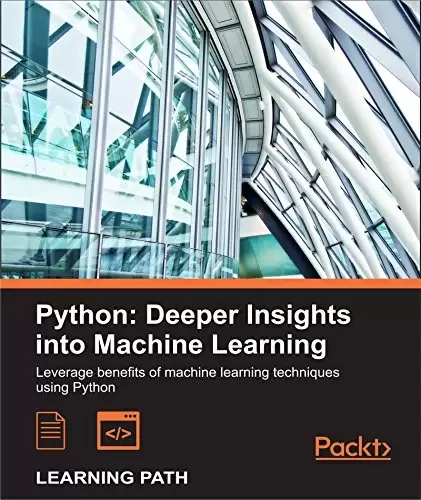
Book Description
Leverage benefits of machine learning techniques using Python
About This Book
- Improve and optimise machine learning systems using effective strategies.
- Develop a strategy to deal with a large amount of data.
- Use of Python code for implementing a range of machine learning algorithms and techniques.
Who This Book Is For
This title is for data scientist and researchers who are already into the field of data science and want to see machine learning in action and explore its real-world application. Prior knowledge of Python programming and mathematics is must with basic knowledge of machine learning concepts.
What You Will Learn
- Learn to write clean and elegant Python code that will optimize the strength of your algorithms
- Uncover hidden patterns and structures in data with clustering
- Improve accuracy and consistency of results using powerful feature engineering techniques
- Gain practical and theoretical understanding of cutting-edge deep learning algorithms
- Solve unique tasks by building models
- Get grips on the machine learning design process
In Detail
Machine learning and predictive analytics are becoming one of the key strategies for unlocking growth in a challenging contemporary marketplace. It is one of the fastest growing trends in modern computing, and everyone wants to get into the field of machine learning. In order to obtain sufficient recognition in this field, one must be able to understand and design a machine learning system that serves the needs of a project.
The idea is to prepare a learning path that will help you to tackle the real-world complexities of modern machine learning with innovative and cutting-edge techniques. Also, it will give you a solid foundation in the machine learning design process, and enable you to build customized machine learning models to solve unique problems.
The course begins with getting your Python fundamentals nailed down. It focuses on answering the right questions that cove a wide range of powerful Python libraries, including scikit-learn Theano and Keras.After getting familiar with Python core concepts, it’s time to dive into the field of data science. You will further gain a solid foundation on the machine learning design and also learn to customize models for solving problems.
At a later stage, you will get a grip on more advanced techniques and acquire a broad set of powerful skills in the area of feature selection and feature engineering.
Style and approach
This course includes all the resources that will help you jump into the data science field with Python. The aim is to walk through the elements of Python covering powerful machine learning libraries. This course will explain important machine learning models in a step-by-step manner. Each topic is well explained with real-world applications with detailed guidance.Through this comprehensive guide, you will be able to explore machine learning techniques.
Table of Contents
1. Module 1
1. Giving Computers the Ability to Learn from Data
2. Training Machine Learning Algorithms for Classification
3. A Tour of Machine Learning Classifiers Using Scikit-learn
4. Building Good Training Sets – Data Preprocessing
5. Compressing Data via Dimensionality Reduction
6. Learning Best Practices for Model Evaluation and Hyperparameter Tuning
7. Combining Different Models for Ensemble Learning
8. Applying Machine Learning to Sentiment Analysis
9. Embedding a Machine Learning Model into a Web Application
10. Predicting Continuous Target Variables with Regression Analysis
11. Working with Unlabeled Data – Clustering Analysis
12. Training Artificial Neural Networks for Image Recognition
13. Parallelizing Neural Network Training with Theano
2. Module 2
1. Thinking in Machine Learning
2. Tools and Techniques
3. Turning Data into Information
4. Models – Learning from Information
5. Linear Models
6. Neural Networks
7. Features – How Algorithms See the World
8. Learning with Ensembles
9. Design Strategies and Case Studies
3. Module 3
1. Unsupervised Machine Learning
2. Deep Belief Networks
3. Stacked Denoising Autoencoders
4. Convolutional Neural Networks
5. Semi-Supervised Learning
6. Text Feature Engineering
7. Feature Engineering Part II
8. Ensemble Methods
9. Additional Python Machine Learning Tools
10. Chapter Code Requirements
中文:
书名:Python:对机器学习的更深入了解
利用使用Python的机器学习技术的优势
关于本书
- 使用有效的策略改进和优化机器学习系统。
- Develop a strategy to deal with a large amount of data.
- 使用Python代码实现一系列机器学习算法和技术。
Who This Book Is For
这个标题是为已经进入数据科学领域的数据科学家和研究人员提供的,他们希望看到机器学习的实际应用并探索其在现实世界中的应用。具备Python编程和数学知识,并具备机器学习概念的基本知识。
What You Will Learn
- 学习编写干净优雅的Python代码,以优化算法的强度
- 通过聚类发现数据中隐藏的模式和结构
- 使用强大的特征工程技术提高结果的准确性和一致性
- 对前沿深度学习算法有实践和理论上的理解
- 通过构建模型来解决独特的任务
- 掌握机器学习设计过程
详细地说
机器学习和预测分析正在成为在充满挑战的当代市场中实现增长的关键战略之一。它是现代计算中增长最快的趋势之一,每个人都想进入机器学习领域。为了在这一领域获得足够的认可,一个人必须能够理解和设计一个服务于项目需求的机器学习系统。
我们的想法是准备一条学习之路,帮助您用创新和尖端技术解决现代机器学习在现实世界中的复杂性。此外,它还将为您在机器学习设计过程中提供坚实的基础,并使您能够构建定制的机器学习模型来解决独特的问题。
课程一开始就掌握了您的Python基础知识。它的重点是回答围绕着一系列强大的Python库的正确问题,包括SCRKIT-学习Theano和Keras。在熟悉了Python的核心概念之后,是时候深入到数据科学领域了。您将进一步在机器学习设计方面获得坚实的基础,并学习如何定制解决问题的模型。
在稍后的阶段,您将掌握更高级的技术,并在功能选择和功能工程领域获得广泛的强大技能。
Style and approach
本课程包括将帮助您使用Python跳入数据科学领域的所有资源。其目的是介绍涵盖强大的机器学习库的Python元素。本课程将循序渐进地解释重要的机器学习模型。每个主题都用真实世界的应用程序进行了很好的解释,并提供了详细的指导。通过这本全面的指南,您将能够探索机器学习技术。
Table of Contents
1.模块1
1.赋予计算机从数据中学习的能力
2. Training Machine Learning Algorithms for Classification
3.使用Scikit学习机器学习分类器之旅
4. Building Good Training Sets – Data Preprocessing
5.通过降维压缩数据
6.学习模型评估和超参数调整的最佳实践
7. Combining Different Models for Ensemble Learning
8.机器学习在情感分析中的应用
9.在Web应用程序中嵌入机器学习模型
10. Predicting Continuous Target Variables with Regression Analysis
11. Working with Unlabeled Data – Clustering Analysis
12.训练用于图像识别的人工神经网络
13. Parallelizing Neural Network Training with Theano
2.单元2
1.机器学习中的思考
2. Tools and Techniques
3.将数据转化为信息
4.模型–从信息中学习
5. Linear Models
6. Neural Networks
7.功能–算法如何看待世界
8. Learning with Ensembles
9.设计策略和案例研究
3.单元3
1.无监督机器学习
2. Deep Belief Networks
3.堆叠式去噪自动编码器
4.卷积神经网络
5. Semi-Supervised Learning
6. Text Feature Engineering
7.特征工程第二部分
8. Ensemble Methods
9. Additional Python Machine Learning Tools
10.章节代码要求
评论前必须登录!
注册